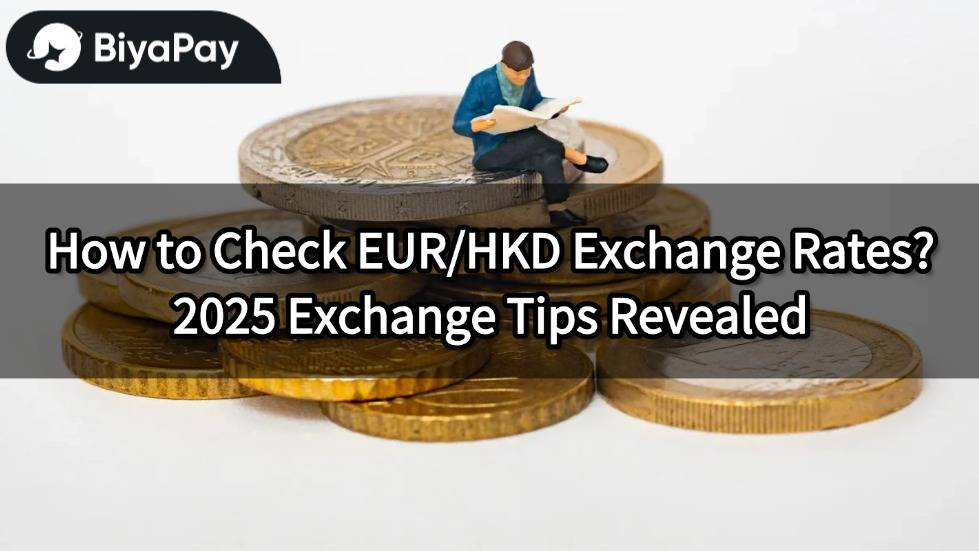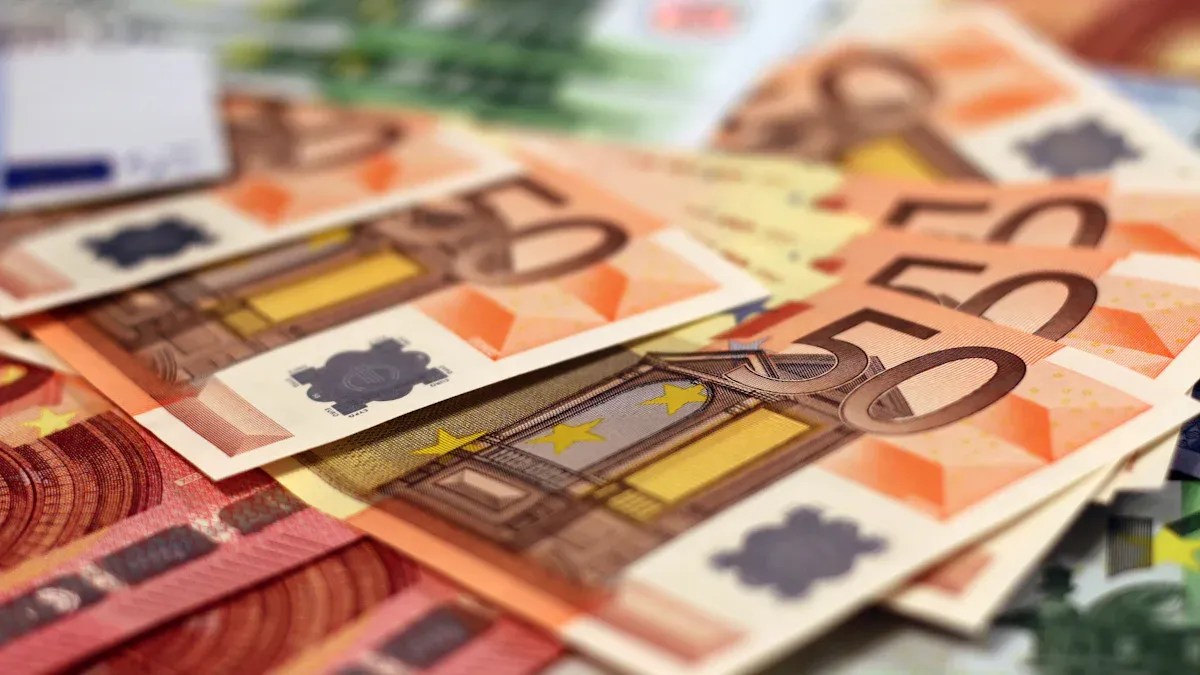- EasyCard
- Trade
- Help
- Announcement
- Academy
- SWIFT Code
- Iban Number
- Referral
- Customer Service
- Blog
- Creator
How to Check EUR/HKD Exchange Rates? 2025 Exchange Tips Revealed

Image Source: unsplash
Do you want to know how the EUR/HKD exchange rate will change in 2025? Recent market volatility has made the timing of exchanges increasingly important. If you plan to travel to Europe or have investment needs, you should monitor exchange rate trends. Choosing the right timing and method can help you save real money. Remember to avoid common pitfalls to protect your interests.
Key Points
- The EUR/HKD exchange rate in 2025 is influenced by multiple factors, with significant volatility, requiring close attention to market and policy changes.
- Choosing the right exchange timing is crucial; you can leverage exchange rate ranges and market session fluctuations, setting target rates to improve exchange efficiency.
- Exchange channels are diverse, including money changers, bank ATMs, brokerage platforms, and multi-currency debit cards; choose the most suitable method based on your needs.
- Compare rates and fees across channels, exchange in batches, and select appropriate denominations to reduce costs and risks.
- Pay attention to safety during exchanges, choose reputable venues, verify banknote authenticity, and use electronic payment tools to enhance security.
Exchange Rate Trends

Image Source: pexels
Recent Changes
You may have noticed recently that the EUR/HKD exchange rate has been fluctuating significantly. Several key factors are behind these changes:
- The US dollar index rose due to strong US retail sales data, driving USD strength and affecting the trends of EUR and HKD.
- Geopolitical events, such as easing tensions in North Korea and terrorist attacks in Spain, have caused market sentiment to fluctuate.
- The Federal Open Market Committee (FOMC) meeting minutes show policymakers are concerned about inflation and considering delaying rate hikes, impacting both USD and EUR.
- The European Central Bank is worried that a strong EUR could affect inflation targets, issuing dovish statements that put pressure on the EUR.
- Weak economic data in the Eurozone, such as a decline in the June industrial index, further impacted the EUR exchange rate.
You need to know that exchange rate systems also affect fluctuations. HKD adopts a linked exchange rate system, while EUR follows a floating exchange rate. Floating rates are determined by the market and exhibit greater volatility. Central banks intervene based on economic conditions, and these policies influence the EUR/HKD trend.
2025 Forecast
Looking ahead to 2025, experts generally believe that the EUR/HKD exchange rate will continue to be influenced by multiple factors. The Hong Kong Monetary Authority recently purchased USD multiple times, injecting over HKD 100 billion, aiming to maintain the stability of the HKD linked exchange rate. The proportion of USD assets in the Exchange Fund has decreased, reflecting diversified asset allocation, which may affect HKD stability.
In the short term, the EUR may remain strong, due to increased European defense spending and USD weakness. However, the European Central Bank may cut rates again by year-end, putting pressure on the EUR. In the medium term, downward revisions to Eurozone economic growth expectations, coupled with US trade barriers and global economic uncertainty, may lead to significant EUR/HKD fluctuations. You should closely monitor European Central Bank policies and global trade situations, as these directly impact future exchange rates.
EUR/HKD Exchange Timing
Exchange Timing
To choose the best time to exchange EUR/HKD, you should first understand recent exchange rate trends. Based on the past 30 days’ data, the EUR/HKD exchange rate has fluctuated approximately between 3.7390 and 3.7432. This range is narrow, indicating relatively stable rates. You can use this data to observe HKD rate highs and lows within the range. For example, when the HKD rate is lower, you can consider buying EUR; when the EUR rate is higher, you can exchange back to HKD. This helps improve exchange efficiency and reduce losses.
Tip: You can set a target exchange rate and exchange when the market reaches that level to better seize the optimal timing.
Rate Fluctuations
You need to know that exchange rate fluctuations vary across different market sessions.
- The Tokyo market in the morning has lower liquidity and smaller fluctuations, with higher risks, making it less suitable for active exchanges.
- During the opening of European and US markets, exchange rate fluctuations increase significantly, making it a better time to monitor market changes.
- Before major economic data releases, rates are usually stable; after releases, fluctuations spike suddenly.
You can use high-low price indicators to observe the highest and lowest prices in each session, making it easier to judge the most advantageous exchange times. Remember, rate fluctuations are influenced by macroeconomic news; you should stay updated on news and market dynamics, adjusting your exchange strategy flexibly.
Exchange Channel Comparison

Image Source: pexels
If you want to exchange EUR/HKD, there are many channels to choose from. Each channel offers different rates, fees, and convenience levels. You should select the most suitable method based on your needs.
Money Changers
Money changers are one of the most commonly used exchange channels for Hong Kong residents. You can find many money changers in large malls, busy districts, or near MTR stations, such as Fat Tat Bird or Flying Bird. These money changers often offer competitive rates, especially for popular currencies like EUR/HKD.
- Advantages:
- Rates are better than banks, especially for cash exchanges.
- Low or no fees.
- Fast exchanges, completed on the spot.
- Disadvantages:
- Some small money changers are less secure due to their scale.
- Higher risk of counterfeit notes.
- Rate fluctuations vary significantly between shops.
Tip: Avoid exchanging at airports or hotels, as their rates are typically the worst. Choose well-known money changers in large malls or busy districts for safety and reliability.
Banks and ATMs
You can also exchange EUR/HKD at Hong Kong banks or ATMs. Different methods come with varying rates and fees.
- Over-the-counter exchanges: Rates are usually the worst, with most banks charging USD 13 to USD 26 per transaction. The advantage is a wide selection of currencies and denominations.
- Foreign currency ATMs: Rates are better than over-the-counter due to reduced labor costs. You can withdraw foreign currency 24/7, but currency options are limited. Some banks waive fees for their own customers, while cross-bank withdrawals incur charges.
- Online banking or apps: You can exchange at better rates, sometimes with additional discounts. However, withdrawing cash still incurs spread fees.
- Advantages:
- High security, suitable for large exchanges.
- Multiple currency and denomination options.
- Online exchanges are convenient, with some banks offering discounts.
- Disadvantages:
- High over-the-counter fees and poor rates.
- Limited ATM currency options, with cross-bank fees.
- Cash withdrawals still involve fees.
Note: ATM exchange rates are generally better than over-the-counter, but you should watch for fees and currency restrictions.
Brokers and Online Platforms
In recent years, more people have used brokers or online platforms to exchange EUR/HKD, such as Interactive Brokers, Futu, or Webull. These platforms leverage fintech and big data to offer low fees and real-time trading.
- Advantages:
- Rates are close to real-time market prices with high transparency.
- Low fees, suitable for large exchanges or investments.
- Platforms integrate various financial information, aiding comparison and decision-making.
- Fast transactions with support for multiple currencies.
- Disadvantages:
- Requires opening a brokerage account, which has a threshold.
- Cash withdrawal processes are complex.
- Some platforms focus on electronic fund transfers, unsuitable for those needing cash.
Tip: If you frequently exchange currencies or invest, brokers and online platforms can save significant fees and time.
Multi-Currency Debit Cards
Multi-currency debit cards (e.g., dual-currency cards, Mastercard multi-currency cards) have gained popularity recently. You can buy EUR at low rate points and pay directly with the card, bypassing the need for cash exchanges.
- Advantages:
- You can lock in low rates instantly, saving cash exchange fees.
- Direct deductions from foreign currency accounts, convenient and secure.
- Real-time transaction notifications and encrypted data enhance security.
- Reduces the risk of carrying large amounts of cash, ideal for travelers and businesspeople.
- Flexible asset allocation minimizes losses from rate fluctuations.
- Disadvantages:
- Requires opening a multi-currency account in advance.
- Some banks or platforms charge annual or management fees.
- Not all merchants accept multi-currency debit cards.
According to statistics, about 90% of JPY dual-currency card transactions and 60% of USD dual-currency card transactions settle directly in foreign currency accounts, showing that multi-currency debit cards effectively improve payment efficiency and security.
You should choose the most suitable exchange channel based on your needs. For small cash amounts, money changers and ATMs are convenient. For frequent travelers or online shoppers, multi-currency debit cards and brokerage platforms are better. Compare rates and fees across channels to get the best EUR/HKD deal.
Exchange Tips
Rate Comparison
To get the best EUR/HKD deal, the first step is to compare rates across channels. You can:
- Compare real-time rates from multiple money changers, Hong Kong banks, and online platforms.
- Note the spread between selling and buying prices, which directly affects your final amount.
- Use limit orders or set target rate functions to exchange automatically when rates hit your desired level, reducing missed opportunities.
Tip: Use online rate comparison tools to quickly check the latest EUR/HKD rates across channels, saving time and effort.
Fees
Fees are an unavoidable cost when exchanging currencies. According to BIS statistics, the average fee for cross-border payments ranges from 7% to 10%. This varies by channel and amount. Technological advancements have reduced fees, but you should still pay attention:
| Channel | Average Fee | Rate Difference | Suitable For |
|---|---|---|---|
| Money Changers | Low or no fees | Better | Small cash exchanges |
| Bank Counter | USD 13-26 | Poor | Large amounts or cash needs |
| Foreign Currency ATM | As low as USD 5 | Better | 24/7 foreign currency withdrawals |
| Broker Platforms | As low as USD 2 | Closest to market | Investments or large exchanges |
You should choose the most cost-effective channel based on your needs and amount to minimize unnecessary fees.
Denomination Choice
When exchanging EUR/HKD, denomination choice is also important. Large-denomination notes are convenient to carry but carry higher risks. You can consider exchanging in batches to:
- Spread the risk of losses due to rate fluctuations.
- Reduce the chance of exchanging at unfavorable rates in a single transaction.
- Minimize losses from rate changes when holding large-denomination notes.
- Based on market experience, batch exchanges help avoid losses at single points, especially during high volatility.
It’s recommended to choose small to medium-denomination notes for daily spending and payments, as they are easier to use and reduce risks.
Safety Precautions
Safety is critical when exchanging EUR/HKD. You can:
- Prioritize large malls or reputable money changers to reduce counterfeit note risks.
- Verify banknote authenticity during exchanges, especially for large denominations.
- Avoid exchanging cash in remote or low-traffic areas.
- Check exchange limits at each money changer or bank to avoid carrying excessive cash.
- Use multi-currency debit cards or brokerage platforms to reduce cash transactions and enhance safety.
Tip: Exchange in batches and store cash separately; if lost, you won’t lose all funds at once.
To exchange currencies, first compare rates and fees across channels. According to 2024 Hong Kong Monetary Authority’s large-scale interventions, the linked exchange rate system remains stable. You can choose money changers, Hong Kong bank ATMs, or brokerage platforms to flexibly handle market fluctuations. In 2022, the EUR plummeted due to the energy crisis, reminding you to monitor international economic news closely. By choosing the right method and exchanging in batches based on your needs, you can reduce risks and get better rates.
FAQ
Does the EUR/HKD exchange rate change daily?
You will see slight daily changes in the EUR/HKD exchange rate. Market news, economic data, and policies all influence rates.
Is there a minimum amount for exchanging EUR/HKD?
Most money changers and Hong Kong banks have no minimum amount restrictions. However, some brokerage platforms may require exchanges of at least USD 100.
How can I avoid counterfeit notes during exchanges?
You should choose large malls or reputable money changers. Check banknote authenticity immediately after exchanging, especially for large denominations.
Do multi-currency debit cards have annual fees?
Some Hong Kong banks or platforms charge annual or management fees. Review terms before opening an account to choose the best product.
Can I negotiate rates when exchanging EUR/HKD?
You can try negotiating at some money changers, especially for large amounts. Comparing multiple shops often helps secure better rates.
The 2025 EUR/HKD rate (7.9765-8.9858) fluctuates with dollar strength and ECB policies, while money changers’ high cash costs and PST time zone challenges complicate cross-border transactions. BiyaPay offers a seamless solution with remittance fees as low as 0.5%, covering 190+ countries for swift transfers. It uses real-time market rates, displayed transparently via the exchange rate calculator, ensuring a convenient experience, and supports fee-free conversion of 200+ digital currencies (like USDT) to USD, HKD, and EUR. A 1-minute BiyaPay registration simplifies global fund management, minimizing exchange risks in 2025.
Streamline your remittances! Join BiyaPay.
*This article is provided for general information purposes and does not constitute legal, tax or other professional advice from BiyaPay or its subsidiaries and its affiliates, and it is not intended as a substitute for obtaining advice from a financial advisor or any other professional.
We make no representations, warranties or warranties, express or implied, as to the accuracy, completeness or timeliness of the contents of this publication.




Contact Us
Company and Team
BiyaPay Products
Customer Services
is a broker-dealer registered with the U.S. Securities and Exchange Commission (SEC) (No.: 802-127417), member of the Financial Industry Regulatory Authority (FINRA) (CRD: 325027), member of the Securities Investor Protection Corporation (SIPC), and regulated by FINRA and SEC.
registered with the US Financial Crimes Enforcement Network (FinCEN), as a Money Services Business (MSB), registration number: 31000218637349, and regulated by FinCEN.
registered as Financial Service Provider (FSP number: FSP1007221) in New Zealand, and is a member of the Financial Dispute Resolution Scheme, a New Zealand independent dispute resolution service provider.




















